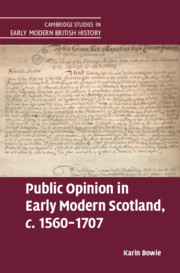Book contents
- Public Opinion in Early Modern Scotland, c.1560–1707
- Cambridge Studies in Early Modern British History
- Public Opinion in Early Modern Scotland, c.1560–1707
- Copyright page
- Contents
- Acknowledgements
- Abbreviations
- Introduction
- Chapter 1 Protestations
- Chapter 2 Petitions
- Chapter 3 Oaths
- Chapter 4 Public Communications
- Chapter 5 The Inclinations of the People
- Chapter 6 The Sense of the Nation
- Conclusions
- Bibliography
- Index
Chapter 5 - The Inclinations of the People
Published online by Cambridge University Press: 21 December 2020
- Public Opinion in Early Modern Scotland, c.1560–1707
- Cambridge Studies in Early Modern British History
- Public Opinion in Early Modern Scotland, c.1560–1707
- Copyright page
- Contents
- Acknowledgements
- Abbreviations
- Introduction
- Chapter 1 Protestations
- Chapter 2 Petitions
- Chapter 3 Oaths
- Chapter 4 Public Communications
- Chapter 5 The Inclinations of the People
- Chapter 6 The Sense of the Nation
- Conclusions
- Bibliography
- Index
Summary
This chapter draws attention to the making of claims about popular preferences to justify a change in church government in the Revolution of 1688-90. The analysis shows how ‘the inclinations of the generality of the people’ came to be included in Scotland’s 1689 Claim of Right to demand the reinstatement of presbyterian church government. This formulation drew on the language of grievance to present what was described as the laity’s instinctive and historical desire for a church without prelacy, while assertive crowds and volunteer forces demonstrated the potential for popular violence if these wishes were not acknowledged. The ensuing Revolution settlement gave constitutional authority to the preferences of the people in church government, stimulating an ongoing debate between presbyterians and episcopalians on the people’s true desires. Pamphleteers provided geographical and social assessments and proposals for direct polling while petitioners sought to demonstrate counter-opinions, reinforcing the prominence of opinion at large in Scottish politics.
Keywords
- Type
- Chapter
- Information
- Public Opinion in Early Modern Scotland, c.1560–1707 , pp. 185 - 210Publisher: Cambridge University PressPrint publication year: 2020

